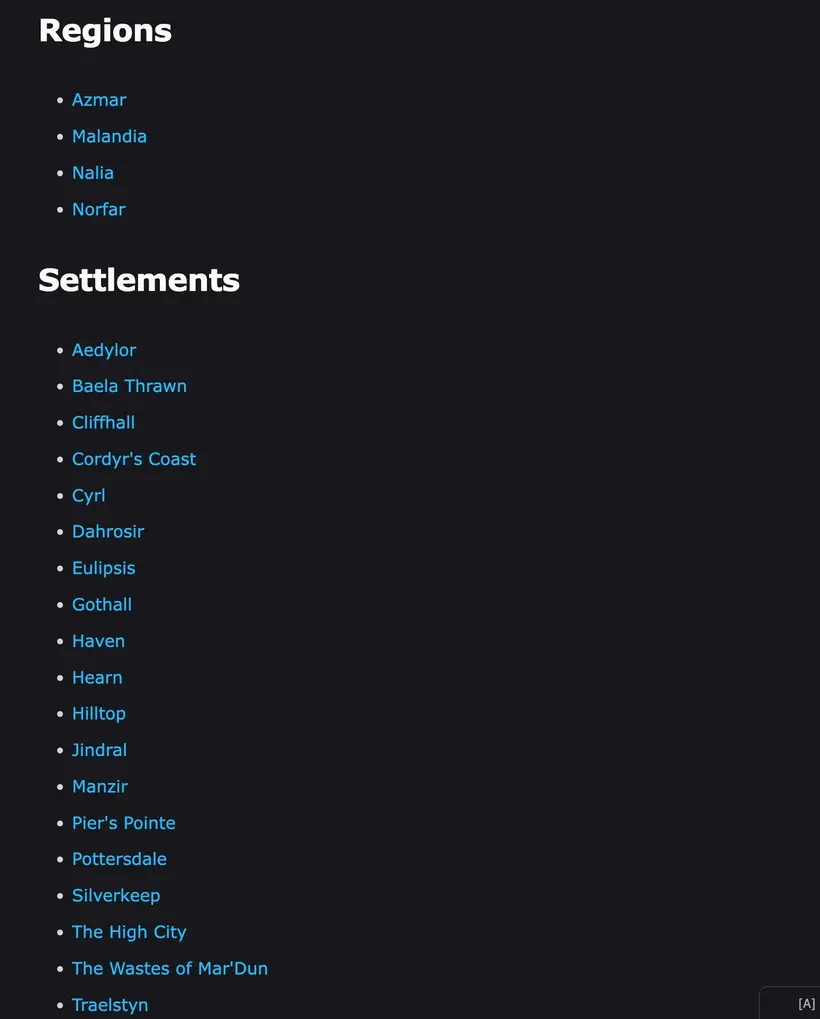Organizing an Atlas for D&D in Obsidian
How to create an atlas to organize your D&D location notes in Obsidian.
When working with Obsidian for Dungeons & Dragons, some notes are easy to organize. You might have a note for each character and a folder for them all. But what about locations? What about locations within locations? What about folders or tags? Let’s take a look at creating a world atlas with Obsidian.
Start with a simple Atlas or Locations folder. If you have one shared setting across multiple campaigns, it makes sense to keep this folder at the root of your vault. You can use campaign-specific tags to keep track of which notes play into each campaign if you like. If you tend to have different settings for each campaign, nest an Atlas or Locations within each specific campaign’s folder. That’s the easy part.
Nested Folder Nightmare
It’s far too easy to default to a hierarchy of “locations within locations” meaning folders within folders. Imagine a folder for your world. Then a folder for each continent. Then a folder for each region, city, etc. But the relativity of locations within our settings doesn’t need to match how they relate in a digital organizational structure. We can decouple those two things—it’s just our brains that try to associate them.
That said, folders are useful for organizing. So where do we draw the line? Here is a paradigm that I sometimes find useful:
- Default to starting with note rather a folder.
- Only add a folder when you need to separate a larger amount of notes that you might want to search though in isolation
My Atlas has a folder for each “setting” in my world. Usually, these are continents. Some are geographically close but conceptually different (or featured different campaigns). Within those settings, there are no more folders. It’s all markdown files. All regions, landmarks, geography, settlements, etc. live in shared or individual markdown files. Because of that, we have no more arbitrary hierarchy leading to a nested folder nightmare. So what does organization actually look like?
Organized Settings
Within each setting folder, I rely on index files and tags to manage my organization. The former is used most often. The latter is a nice-to-have (but not necessary) method of organization.
Index Files
For a setting index, I use Dataview queries and tags to populate a section for Regions and Settlements within that setting. The result looks something like this:

You don’t need Dataview and tags—you can just type out each section and how you want it to appear. Dataview just automates this as I add new notes and reduces manual work to add a list containing dozens of notes. Here’s a general example of the type of Dataview query I use to generate these:
LIST from #settlement WHERE contains(file.folder, this.file.folder) AND file.name != this.file.name SORT file.name ascTags and Properties
As mentioned above, I use tags to power Dataview queries. But they’re also useful for powering search. For example, the following search will give me all settlements within my Aer setting: path:Atlas/Aer tag:#settlement. Here is a list of tags that I use for my Atlas:
#region#landmark#geography#settlement
Per this article I also use nested tags instead of custom properties. Here are examples:
#region/world,#region/major,#region/minor#landmark/ruin,#landmark/estate,#landmark/crypt#geography/mountain,#geography/volcano,#geography/forest#settlement/city,#settlement/village,#settlement/town
Between customized searches powered by tags and referencing index files, I have no need for a complicated folder structure within each setting.
The Simple Truth
If any of this feels like too much and a bit overwhelming, you’re in luck. You don’t need any folders or tags to organize your locations. Obsidian’s search is far more powerful and faster than your ability to navigate files and folders. Most organization methods will provide minimal value beyond presentation or personal preference.
Whatever your strategy, aim to avoid wasting brainpower wondering, “Where should this file go?” when creating something new. Achieve that, and you’re doing it right.
Game on.
